
Ranking every desktop Mac design based on color options
Rankings are often sterile and boring, based on hardware specifications that lose relevance or other droll data points. Even basing them on the impact on the industry is overdone, so what say we have a little bit of fun? Instead of concrete evidence, I decided to rank every desktop Mac model based on how fun the color options were. Now, Apple’s product stack through the 80s and most of the 90s was drab, utilitarian, and predominantly beige. So we’re going to skip it. Well, except for the Macintosh 128K, which I’m going to give a special mention to now, as it wasn’t just the first Mac as we know it, but a surprisingly endearing piece of functional design that is still cute four decades later.
1
iMac G3
The proof that PCs didn’t have to be boring beige
Ahh, the iMac G3, with its kaleidoscope of colors and clear casing. It was the first device to catapult Jony Ive’s design sensibilities into the limelight. Up until this point, every computer was a boring, bland, beige box, including the few dozen in Apple’s product catalog. Like the Apple IIc I learned to type on, the iMac G3 had a handle for carrying it around, which is just as well because you didn’t want to be apart from it. The first computer to offer USB ports as a standard feature, it had a CD-ROM drive, and all the ports were hidden behind a color-coded door that matched the top of the shell, and the speaker covers. Glorious design and fab colors left an impact on many other tech devices, including the PlayStation designs of that era. And there was a matching laptop, the iBook G3, but maybe that’s worthy of another list, partly because it was the world’s first Wi-Fi-enabled laptop.
2
Power Macintosh G3
More clear plastic and a toolless design for improvements
Introduced the year after the Bondi Blue iMac G3, the Power Macintosh G3’s case was made of the same combination of striking blue and translucent plastic. What a winner from the outside, and the matching Apple Studio Display made for a powerhouse presentation on top of any creative’s desk. This was the desktop PC to own in 1999, at least if you wanted to do animation or digital film effects. It was twice as fast as the leading Intel Pentiums at the time, could have up to 1GB of RAM, 100GB of storage space, and had a 16MB ATI Rage discrete graphics card, the first PC to ship with one. FireWire was built-in for super-fast connectivity to cameras and other devices, and USB was standard. Oh, and it was blue and clear, instead of the boring boxes that Windows PCs came in.
3
iMac M1, M2, M3
Back to the winning rainbow formula
The shift to Apple Silicon in the iMac 24″ (2021) brought power, a gorgeous screen, and an iMac that blew away reviewers everywhere. But it also brought one even more important thing to the market: a huge helping of fun. Instead of beautifully dull silver aluminum, the iMac came in six bright colors. Okay, seven colors because silver was still offered, but the yellow, orange, purple, pink, green, and blue options are the important ones here. Even better, the accessories can be purchased in color-matched hues, so your Magic Mouse and Magic Keyboard can color-coordinate with your computer. Not since the iMac G3 has an out-of-the-box computer looked so awesome, and the yearly upgrades to the M2 and M3 chips kept the same color options.
4
Power Mac G4
Graphite and translucent plastic once again
The Power Mac G4 was launched in the summer of 1999 with a modified version of the G3’s case. This time, it was more transparent around the body and had a graphite color instead of the white and blue of the G3. Two more color options would come in the years before the G4 was retired; QuickSilver, which was clear and silver, and “Mirrored Drive Doors,” (yes, that’s the official name), which unsurprisingly had a silver mirrored panel over the optical drive. Fun stuff and the G4 had cool hardware, too, like dual processors and firsts like gigabit Ethernet, and later on, optional Bluetooth and AirPort Extreme cards for wireless connectivity.
5
Power Mac G4 Cube
What’s not to like about a cube inside a cube?
The Power Mac G4 Cube was a resounding commercial failure, which is a shame because it was awesome. An aluminum cube inside a transparent acrylic cube? With matching speakers, monitor, keyboard, and mouse? I’m here for that, and it would be a perfect use of Apple Silicon and other modern technology. Sure, it inspired the Mac mini to be created, because Jobs always wanted a miniature but powerful computer, but something of its soul was lost in the move to all-aluminum enclosures.
6
Mac Pro (2nd gen)
Yes, the infamous trash can
The cylinder Mac Pro appeared at the end of 2013 with a shiny black exterior. Well, 99.99% of them anyway, as a single Mac Pro was given the Product Red treatment with a beautiful red finish. The “trash can,” as they became affectionately nicknamed, had a central thermal dissipation core with a single fan bringing in air from the bottom and pushing it up the chimney. It was the first black Mac until the iMac Pro, and Apple still uses the shade on other Pro lines. It was also upgradeable, with a socketed Intel Xeon server processor that can be easily swapped out. The dual graphics cards, however, couldn’t be, dooming this Pro model to the scrapheap.
7
iMac Pro
Not to be confused with the Mac Pro
Another basic black model joins our rankings, but the hardware inside the iMac Pro was anything but basic. With Intel Xeon processors and AMD Vega graphics, the all-in-one iMac was a cut above the consumer-level, silver iMacs of this era. It used the same chassis as the consumer iMac, just in “space gray,” which is significantly darker than the current shade used for that name. And yes, the Magic Keyboard, Magic Mouse, and Magic Trackpad all came in the same shade because it isn’t an Apple product unless you can color-coordinate every accessory.
8
iMac G4
Weird, but oddly wonderful
You might wonder why the quirky, peak Apple doing things differently, iMac G4 is all the way down this list. It’s simple: It came in one color, glossy white. The all-in-one personal computer is about as different as you could get in 2002, with a dome containing the logic board and other hardware and a display on a stick attached on top. It was made possible by the industry’s move to LCD panels instead of bulky CRTs, like the one the G3 was based on. But, the company decided to kick the transparency of the G3 to the curb, and made the G4 opaque white.
9
Mac mini
Started out strong, then got boring
The current generation Mac Mini is a pocket-sized powerhouse housed in the usual premium aluminum associated with Apple products. The Mac Mini G4 was much more fun, with polycarbonate plastic capping the aluminum housing and a slot-loading optical drive with options for DVD playback or DVD writing. Until it gets the color spread of the current iMacs, it’s going to stay down the rankings.
10
Mac Pro (3rd gen)
The expensive cheese grater
Source: Wikimedia commons
The latest aluminum cheese grater design of the Mac Pro is the only Intel-powered Mac in the range now, possibly because the company hasn’t figured out how to make discrete graphics cards play nice with Apple Silicon. While the chassis is interesting, the color choice is not, being silver aluminum. It didn’t even get the black anodizing treatment that earlier Mac Pro models received, or a Project Red makeover. It is super powerful, though, with 10 gigabit Ethernet, up to two AMD Radeon Pro GPUs, and a custom Afterburner card to accelerate ProRes video work.
11
Power Mac G5
The OG cheese grater
The replacement for the Power Mac G4, the G5 was launched with a silver aluminum chassis, with a distinctive shape and front panel that made many think of a cheese grater. It was as beautiful inside as out, with compartments covering any PCBs that would have ruined the aesthetic. But it only came in one color, and that’s all we’re ranking for today. The chassis has a timeless appeal, though, leading enthusiasts like our own Brady Snyder to cut up the insides and put a modern gaming PC inside.
12
Mac Pro (1st gen)
Sleek and stylish, and stayed around for ages
The Power Mac G5 design was timeless; it was also in active production for a very long time, as Apple used it in the first generation of Mac Pro towers. The only tweaks it received were a new optical drive at the front, and the I/O ports being rearranged on both the front and back. Sadly, the refresh didn’t come with another color option, so it stays in the section of nice-but-boring aluminum chassis.
13
iMac (Intel-based)
From boring white to even more boring aluminum
14

In 2006, Apple transitioned away from PowerPC processors, and the first Intel-based iMacs arrived. First in glossy white polycarbonate, then in silver aluminum and plastic after one year. They would stay in aluminum chassis until discontinuation in 2020, with a few design changes to slim down in the years between. Still, they only came in one color option, even when they had multiple screen sizes.
15
iMac G5
A literal blank canvas as the blueprint for successive iMacs
The iMac G5 merged the computer into the screen once again, making the blueprint for all iMacs to this day. On another list, that would have given it a much different ranking, as the current iMac is a refinement of this all-in-one design. But, it only came in white polycarbonate, and was reused for the Intel-based iMacs before those also transitioned to silver aluminum. As such, it came in a boring color, and is a fitting Mac to round out this list.
The Mac range was more fun before everything was sandblasted aluminum
There’s a clear demarcation in Apple’s product offerings between the early models and when Steve Jobs came back to take over, with Jonathan Ives to helm the designs. On his return, Jobs axed the complicated stack of desktop Macs, replacing it with the iMac G3 and the more professional G3 Power Macs. That was also the first time Apple used bold colors and designs, and it saved the company. There would have been no iPhone or iPod without those transparent plastic iMacs, and the world would be a very different place. That’s why I love the new iMacs, which bring color back to the range. If only the same could happen to the MacBooks…












